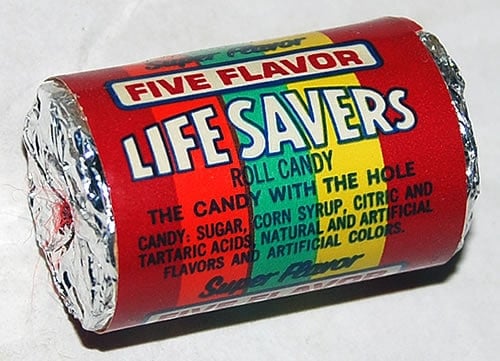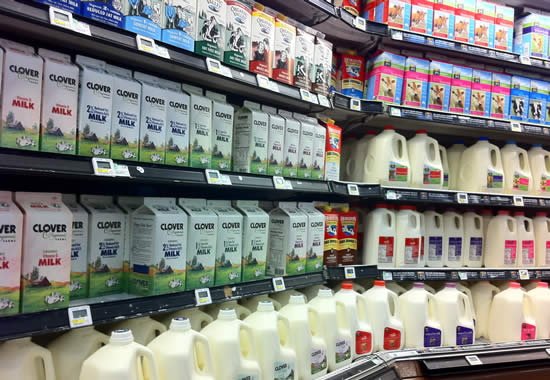Natural & Artificial Flavors
Oct 28, 2010, Updated Jun 17, 2014
Erin Coates, RD, LD, writes about the importance of staying healthy through the foods we eat at The Healthy Apron, sharing delicious recipes along with diet and fitness information. I’ve asked her to write about Natural and Artificial Flavors, those ubiquitous and vaguely-defined ingredients that seem to show up in almost every processed food.
If you just discovered October: Unprocessed, welcome! Find out more and take the pledge. Don’t worry about joining late — you can start your 30 days today or simply join in for the rest of the month.

We make the switch to organic produce, start limiting our intake of processed foods, avoid ingredients that we cannot pronounce, and yet there are still some ingredients that we may be overlooking. How many of us skim over natural and artificial flavorings, never thinking twice about them?
If I were to ask you to choose the healthier flavor of the two, most Americans would believe “natural” flavoring indicates something healthy and that “artificial” flavoring must not be healthy.
It is completely understandable to have these thoughts, but are we being mislead?
What it might mean to you or me does not necessarily match up to what food makers label “natural.” The FDA created an official definition of natural flavoring, published in the Code of Federal Regulations (21CFR101.22), in a long-winded effort to plug as many loopholes as possible. Robert L. Wolke, at the Washington Post, sums it up:
“In simple terms, a natural flavor is defined as a substance extracted, distilled, or otherwise derived from plant or animal matter, either directly from the matter itself or after it has been roasted, heated or fermented . . . Note also that a natural flavor need not come from the very food it is flavoring. For example, a flavor chemical derived from chicken — and it need not taste like chicken — can be used to flavor a can of beef ravioli.”
Artificial flavors on the other hand, are simply any flavoring substances that do not fit the definition of natural flavor.
Ultimately, difference between the “natural” and “artificial” designation is related only to the original source(s) of the chemicals. The end product is always a man-made compound. To approximate the actual flavor of a food, flavorists may blend dozens, and sometimes hundreds, of different chemicals in a lab.
Manufacturers take the extra steps to meet the “natural” definition simply because consumers believe they are healthier and will pay more for them.
So why do we have natural and artificial flavorings? Certain flavors found in nature cannot be exactly or inexpensively recreated. Foods like fruits and vegetables can contain hundreds of naturally-occurring chemical compounds to make up their distinct flavors.
Here are two examples, from Wolke’s article:
- Benzaldehyde is a chemical naturally found in almonds that is responsible for that “almondy” taste. Almond flavoring is synthesized from lab-made benzaldehyde because it is cheaper than extracting it from real almonds.
- The vanilla bean gets most of its flavor from the chemical compound vanillin. Synthetic vanillin can be made by several chemical processes and is known on shelves as imitation vanilla flavoring. Pure vanilla extract is when vanillin is extracted into alcohols and natural vanilla flavor is synthetic flavor made by fermenting ferulic acid and not by combining chemicals in a lab.
So what are the health effects of some of the chemicals that make up natural and artificial flavors? It was very challenging to find information about the actual, studied health effects of these flavors, which makes me even more apprehensive about eating them — even if they’re “generally recognized as safe.” The following are a few examples:
- Benzaldehyde: Contains hydrogen cyanide, causing central nervous system depression and convulsions.
- Vanillan: Can cause allergic reactions.
- Amyl Acetate (pear and banana oil): Many artificial flavors are made with this chemical which may cause nervous system depression, indigestion, chest pain, headaches, fatigue, and irritate the mucus membranes.
- Benzyl Acetate: May cause gastrointestinal, bronchial, skin, and eye irritation.
- Bornneol: Artificial flavoring that may cause GI irritation, seizures, confusion, and dizziness.
- Butryic acid: Has caused cancer in lab animals.
- Carvacrol: Artificial flavor that can lead to respiratory and circulatory depression, as well as cardiac failure
- Cinnamyl formate or formic acid: Artificial cinnamon that has caused cancer in mice and may affect our kidneys. (I found “cinnamon flavor” listed as an ingredient in my Kashi cereal!)
Ultimately, all of these ingredients are almost always grouped under the extremely vague terms “natural flavors” or “artificial flavors” in ingredient labels. You may never know if one or 100 chemicals are used in a product.
As consumers, it is scary to think that we don’t fully know what it is we are eating. We need to make a voice and take a stand against big corporations controlling our food systems; it is essential to the health of the present and the future!
What can you do? First, don’t fall for the “natural” hype. Second, you may want to avoid foods with any kind of flavoring. Third, when you see a product that has flavorings, contact the company — ask them to reformulate their products so that flavorings are no longer necessary, or at least to specify exactly what these flavorings are in the ingredient lists.
If we start voting with our wallets — and making our voices heard — companies will respond.
—
Photo by Roadsidepictures.




















If you’re looking for healthy food, you need to move. The USA is based on the idea of profit and greed.. the quality and dignity of food considered fit for human consuption is horrifying. Western Europe is the place to eat healthy food.. the food purity laws there do not allow adulterated foods… We see it as a sort of civil right.. a freedom… In America you have sold your rights for money.
There is a lot of healthful food in America, but right now it does take effort and diligence to find it. The only way that’s going to improve is if we continue to seek it out. Voting with our dollars does actually work (probably more effectively in America than anywhere else, too!). I’d rather fight from within than just throw my hands up and give up… I guess deep down I’m an optimist.
Also, the weather in Southern California is really nice. 😉
Great post! I for one became familiar with “natural flavors” because my toddler nephew has a SEVERE lactose intolerance. We got him off all of the normal suspects and he was still sick. So we dug deeper and deeper and learned that “natural flavors” were a problem (along with many other preservatives, etc.).
For now? Except for a few exceptions, if it comes in a jar, box or bag, he can’t have it PRIMARILY because of natural flavors. Even many “non-junk food” types of things have natural flavors (apple juice!).
Thanks again! Timely too, because Greta just did a great post on What’s in it Wednesday for Candy Corn – eeeeek – and a big question mark was natural flavors.
http://middleagedjock.wordpress.com/2010/10/28/whats-in-it-wednesday%E2%80%94halloween-edition/
Hi Kris, My guess is that not all flavors are bad for us. The problem is, with the current labeling systems, there’s absolutely no way to tell what’s in those flavors. Perhaps it’s a minor problem for most, but as you point out, your nephew can’t tolerate them. I’ve seen a push to get companies to at least indicate the source of the flavoring (wheat, soy, whatever…) which would certainly be helpful — but only so far as specific allergies go. What about all the other chemical compounds that may be in the flavoring? One of the biggest revelations I had last month was how much “natural flavor” is used — even in products I thought were good for me. It’s been a big disappointment, sadly. Now that the challenge is over, I’m trying to figure out how much to allow back into my diet. I’m going to do my… Read more »
GREAT post! I couldn’t agree more. The word “natural” needs to be banned. It’s too ambiguous and marketers totally take advantage of customers with this term.
When it comes to artificial sweeteners, I use a few, but all in moderation. I don’t just stick to one because there are studies that show problems with all of them. If I mix them up, I figure what’s the harm?! 🙂
Hi Gina,
I’ve actually written before about how the word “natural” is meaningless — and that consumers should ignore that word. Better yet, they should beware. Whenever I see “natural” on a label (or any health claims, for that matter), I’m immediately more skeptical!
Interesting strategy with the artificial sweeteners. Guess you’re hedging your bets? Personally, I prefer to use less sweeteners in general — I’ve been doing it long enough that my palate has adjusted. Just a little sugar (honey, maple syrup, whatever’s least processed!) goes a long way for me.
Love your latest post that shows your pantry, by the way. Way to walk the talk! You’ve just gained a new reader. 🙂
– a.